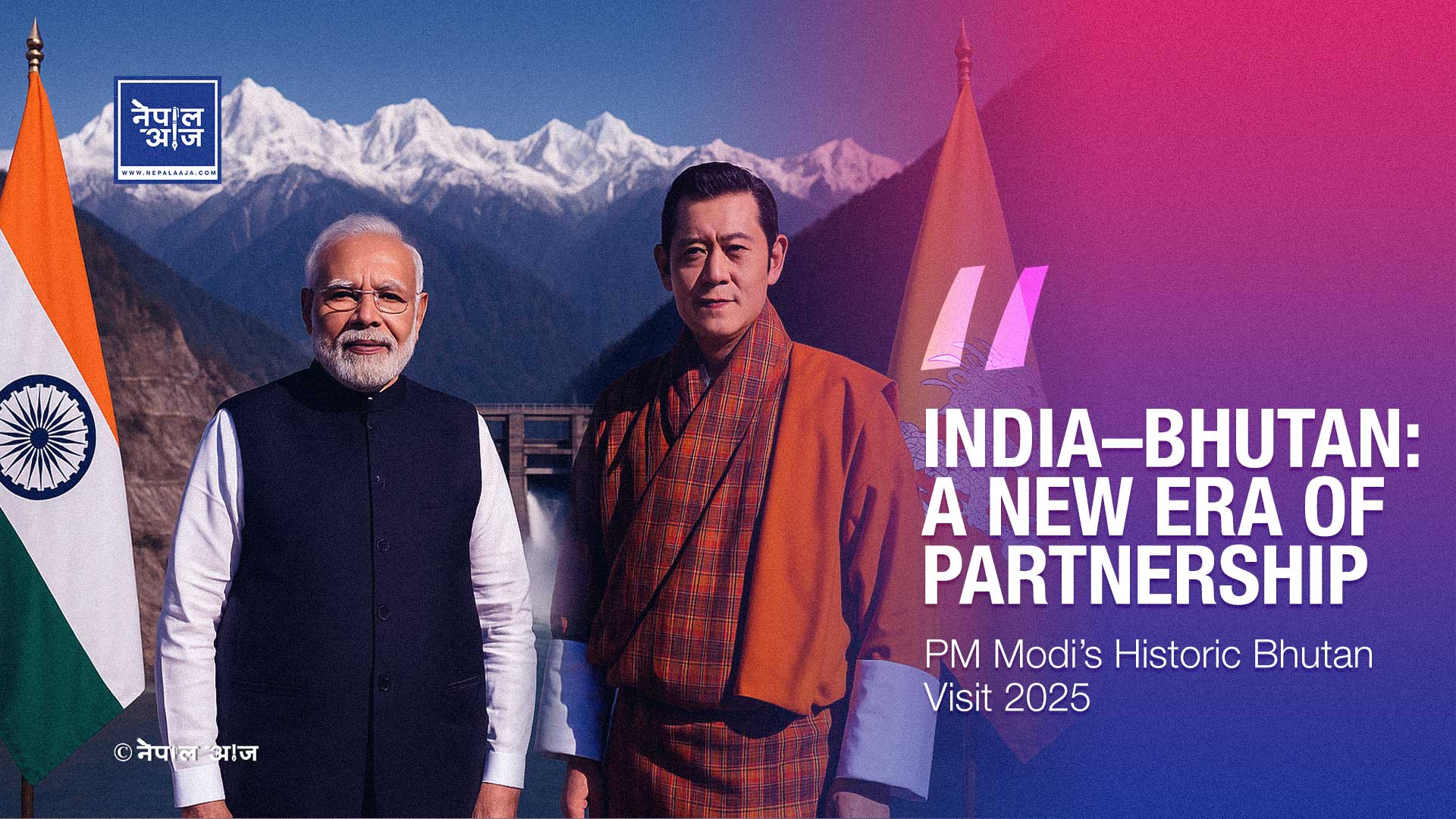India and Bhutan Chart a Shared Path to Sustainable Development and Prosperity
India’s Prime Minister Sh. Narendra Modi’s Visit Heralds a New Era in India–Bhutan Partnership

India and Bhutan share a strong and mutually beneficial partnership in trade and investment. India remains Bhutan’s largest trading partner, accounting for over 80% of Bhutan’s total trade with the world. Beyond commerce, India is also a major source of foreign investment in Bhutan, contributing nearly 55% of the country’s total FDI inflows. This robust economic relationship reflects deep-rooted trust, geographical proximity, and policy alignment between the two nations, with India playing a vital role in Bhutan’s industrial development, hydropower expansion, and overall economic growth.
The friendship between Bhutan and India has long been described as a “heart-to-heart” relationship, rooted in shared geography, culture, and spiritual heritage, yet evolving today into a partnership of strategic depth and economic ambition. On 11 November 2025, Indian Prime Minister Narendra Modi embarked on a landmark two-day state visit to Bhutan, widely viewed as a defining moment for the next decade of bilateral cooperation.
Against a backdrop of decades-long camaraderie and 21st-century, transformation, the visit highlighted trade, investment, infrastructure, and a new era of strategic connectivity. It reflected the transition of India-Bhutan ties from tradition to transformation, anchored in mutual trust and a shared vision of sustainable prosperity.
Decades of India Bhutan Heart-to-Heart Friendship
India-Bhutan relations are exceptional in South Asia because they combine emotional affinity, strategic consistency and developmental partnership. India was among the first to recognise Bhutan’s sovereignty, formalised through the 1949 Treaty of Friendship, revised in 2007 to reflect Bhutan’s growing global role. Over time, India became Bhutan’s principal development partner, financier of major infrastructure, and chief trade and transit facilitator.
Bhutan, in turn, has looked to India not only for economic support but also for cultural and educational exchange, hydropower collaboration, and regional stability. Shared Buddhist heritage and open borders reinforce people-to-people warmth. This relationship, nurtured through high-level visits and consistent dialogue, has matured from one of assistance to a partnership based on respect, interdependence and mutual benefit.
21st-Century Bonding Between India and Bhutan
In the 21st century, India and Bhutan have expanded their partnership from aid-based cooperation to dynamic, multi-sectoral collaboration. The two countries have institutionalised dialogue mechanisms and launched visionary frameworks such as the 2024 Joint Vision Document on Energy Cooperation, covering hydropower, solar energy, green hydrogen and energy security.
Under India’s “Neighbourhood First” policy and Bhutan’s “Economic Diversification” strategy, ties have grown in fintech, space cooperation, digital payments, and education. The 2016 Agreement on Trade, Commerce and Transit further liberalised Bhutan’s market access and improved logistics. These developments reflect a shift towards equality and joint problem-solving — an evolution from a donor-recipient model to one of co-creation and co-investment.
Economic and Business Collaborations
India remains Bhutan’s largest trade and investment partner, with Indian FDI constituting more than 55% of Bhutan’s total foreign direct investment. Indian enterprises operate across key sectors — banking, power generation, manufacturing, food processing, ICT, pharmaceuticals, and hospitality. India has been instrumental in funding Bhutan’s major hydropower projects, often through a combination of grants and soft loans, demonstrating how commerce and development can go hand-in-hand.
Infrastructure and Connectivity
Infrastructure is the backbone of Bhutan’s development story. Indian-assisted projectsfrom the Chukha and Tala hydropower plants to the recently inaugurated Punatsangchhu serieshave transformed Bhutan’s economy. Road connectivity, transmission grids and border trade routes have linked the two economies more closely.
Emerging projects, such as rail connectivity from Assam’s Kokrajhar to Gelephu and Banarhat to Samtse, are expected to redefine trade corridors and cross-border mobility. Infrastructure, therefore, is not only an instrument of growth but also of geopolitical trust.
India-Bhutan Bilateral Trade and Investments
India is Bhutan’s dominant trade partner , accounting for about 80% of Bhutan’s total external trade. Bhutan’s exports to India largely include hydropower, ferro-silicon, wood and mineral products, while imports from India comprise machinery, fuel, consumer goods and industrial inputs.
The 2016 Trade and Transit Agreement guarantee duty-free transit for Bhutanese goods through Indian territory to third countries, while designated Land Customs Stations at Jalgaon-Phuentsholing, SamdrupJongkhar and Gelephu facilitate smooth trade flows. The challenge ahead lies in broadening Bhutan’s export base, reducing structural dependency, and promoting joint ventures that add value within Bhutan itself.
Trade between India and Bhutan rose from USD 484 million in FY 2014-15 to USD 1430 million in 2021-22 and USD 1905 million in FY 2024-25, demonstrating consistent expansion. Going ahead, both countries are now exploring opportunities in clean energy, digital technology, agro-processing, tourism, and wellness services.
India- Bhutan Bilateral Trade (USD Million)
|
Year |
India’s Exports to Bhutan |
India’s Imports from Bhutan |
India Bhutan Total Trade |
|
2021-22 |
885.81 |
545.04 |
1430 |
|
2022-23 |
1079.09 |
535.61 |
1614 |
|
2023-24 |
963.73 |
339.11 |
1302 |
|
2024-25 |
1263.83 |
641.71 |
1905 |
Source : Compiled from Ministry of Commerce, GOI
India’s exports to Bhutan comprise a diverse range of essential and industrial goods that sustain Bhutan’s economy and strengthen bilateral trade ties. Major export items include petroleum products, vehicles, machinery, cereals, iron and steel, electrical equipment, and construction materials. India also supplies pharmaceuticals, food products, plastics, and chemicals to Bhutan. These exports support Bhutan’s infrastructure development, energy sector, and consumer markets. With seamless connectivity, preferential trade terms, and rupee–ngultrum parity, India remains Bhutan’s largest trading partner, accounting for over 80% of its imports. The growing export basket reflects deep economic integration and India’s role in Bhutan’s modernization and industrial growth.
India’s imports from Bhutan are primarily driven by hydropower, minerals, and agricultural products, reflecting the natural resource complementarity between the two nations. The main import items include electricity, ferrosilicon, cement, gypsum, dolomite, and cardamom, along with products like wood, chemicals, and precious stones. Hydropower exports from Bhutan form the backbone of bilateral trade, contributing significantly to Bhutan’s revenue and India’s clean energy needs. Agricultural and mineral imports also support India’s manufacturing and construction sectors. This trade relationship underscores the mutually beneficial nature of India–Bhutan economic ties, where sustainability, energy cooperation, and regional integration remain key pillars of growth.
Investment relations have become the new frontier. Indian investors hold major stakes in Bhutan’s hydropower sector. As Bhutan builds its Gelephu Mindfulness City, Indian participation is expected to be pivotal in infrastructure, digital ecosystems and skill development.For Bhutan, Indian capital and technology are crucial. For India, Bhutan offers a secure, environmentally conscious and reliable investment environment. The emphasis now is on balanced, sustainable, and high-value collaboration.
Defining Moments of Honourable Prime Minister Narendra Modi’s Visit to Bhutan
Honourable Prime Minister Sh. Narendra Modi’s two-day visit to Bhutan in November 11-12, 2025 marked a milestone in the bilateral journey and reflected India’s commitment to deepening neighbourhood diplomacy.During the visit, the two sides announced major outcomes:
- Inauguration of the 1,020 MW Punatsangchhu-II Hydroelectric Project, built with Indian support — symbolising continuity in the energy partnership.
- Resumption of work on the main-dam structure of the 1,200 MW Punatsangchhu-I Project, ensuring its timely completion.
- Extension of a ₹4,000 crore (US$ 455 million) line of credit from India to Bhutan, reaffirming India’s role as a development partner.
- Establishment of an immigration check-post at Hatisar (across Gelephu) to enhance connectivity and tourism.
- Allocation of land in Varanasi for a Bhutanese temple and guest-house, symbolising cultural and spiritual ties.
- Signing of two MoUs — one on renewable energy cooperation covering solar, wind, biomass, energy storage, green hydrogen and capacity-building; another on cooperation in health and medicine focusing on pharmaceuticals, diagnostics, traditional medicine, maternal health, tele-medicine and research.
India’s Prime Minister also attended Bhutan’s national celebrations and the 70th birth anniversary of the Fourth DrukGyalpo, participating in a Global Peace Prayer Festival in Thimphu. His interactions underscored both cultural solidarity and strategic purpose.
The visit was thus both substantive and symbolic, strengthening Bhutan’s developmental goals while reinforcing India’s “Neighbourhood First” commitment. Media commentary described the outcomes as a “blueprint for a future-ready partnership.”
India Bhutan Charting the Next Decade
The India-Bhutan partnership is now poised to enter a transformative decade, integrating traditional energy and connectivity cooperation with modern digital and green sectors.
Energy Cooperation : The hydropower sector will remain the cornerstone of bilateral ties, the 2025 MoU on renewable energy expands cooperation into solar, wind, and hydrogen, signalling a shift towards climate-smart collaboration. Integration of Bhutan’s hydropower into India’s regional grid could also strengthen South Asian energy security.
Connectivity Revolution:The proposed railway links and improved border management systems will deepen trade, tourism and people-to-people exchange. The new immigration check-post at Hatisar will boost access to Bhutan’s southern corridor, particularly the Gelephu Special Administrative Region — envisioned as a hub for mindfulness-based tourism and green industry.
Digital, Health and Youth Cooperation:The agreement on health and medicine introduces a new social-sector dimension to the partnership. Expansion of UPI-based payments, cross-border digital connectivity and joint research programmes for youth and start-ups will redefine bilateral cooperation in human capital and innovation.
Investment and Trade Vision:Both countries aim to transition from resource-based trade to investment-led growth. Encouraging Indian manufacturing in Bhutan, joint service exports, and knowledge-based industries will promote resilience and shared prosperity. The emphasis is on creating value chains that benefit both sides equitably.
Strategic Balance and Sustainability:At the geopolitical level, India-Bhutan cooperation is crucial for Himalayan stability. As Bhutan navigates economic modernisation while safeguarding environmental integrity, India’s role as a partner in green growth will be vital. Sustainable hydropower, eco-tourism and digital inclusion will define the next chapter.
In conclusions, from the foundations of a warm, “heart-to-heart” friendship, India and Bhutan have built a modern partnership of purpose and progress. India’s Prime Minister Sh. Narendra Modi’s 2025 visit encapsulated this evolution, blending culture with commerce, spirituality with strategy, and emotion with execution.
The inauguration of key hydro projects, new lines of credit, and MoUs in energy and health have redefined priorities for the decade ahead. With enhanced connectivity, digital collaboration and people-centric programmes, India and Bhutan are together shaping a Himalayan growth model rooted in sustainability and shared prosperity.
As trade deepens, investments diversify, and infrastructure connects the borderlands, the partnership is moving from sentiment to substance, from symbolic gestures to tangible outcomes. For India, Bhutan remains a great steadfast friend and a strategic anchor in the Eastern Himalayas. For Bhutan, India is both a trusted ally and an enabler of its modernisation journey.




![From Kathmandu to the World: How Excel Students Are Winning Big [Admission Open]](https://nepalaaja.com/img/70194/medium/excel-college-info-eng-nep-2342.jpg)
